
Becky Hitchin considers the impact of rising water temperatures on coral reefs across the world.
Coral reefs are one of our most precious ecosystems, critical in providing safety, food security and livelihoods to more than 1 billion people worldwide. They contribute to local economies, not least through tourism, with an estimated 70 million visitors to coral reefs annually. However, approximately half of the world’s live coral cover on coral reefs has been lost since the 1870s, with accelerating losses in recent decades, particularly associated with bleaching events. The first mass coral bleaching event we know about occurred in 1998, and it killed approximately 8% of the world’s coral.
Since then, as bleaching events have increased in frequency and intensity on the world’s coral reefs, coral has found it ever more difficult to recover to some extent between events, and by 2018, 14% of coral is known to have been lost.
Coral reefs are particularly vulnerable to climate change and are projected to decline further to 10 to 30% of former cover if we undergo a 1.5°C warming, and to less than 1% of former cover at 2°C warming. The future of our reefs varies greatly among and within countries, depending on forecasts of water temperature and weather patterns.
When corals are stressed, they can expel the algae
Climate change affects coral reefs in many ways. The main one, as mentioned above, is through bleaching, though ocean acidification also plays a role.
Let’s start with coral bleaching. Corals live in a mutually beneficial relationship with microscopic algae that live in their tissues, known as zooxanthellae. These tiny algae gain a protected place to live, and provide the coral with up to 95% of its needed nutrients, such as amino acids and glucose. These are needed by the coral to grow their calcified skeleton and their food products.
When corals are stressed, they can expel the algae, which we see when corals turn from their normal bright and beautiful colours to a stark white. If the temperature stays high, the coral will not let the algae return after being expelled, and the coral will die. All it needs is a change in water temperature of 1-2°C over several weeks to cause coral to drive out their algae.
Also affecting corals is a phenomenon known as ocean acidification, the ongoing decrease in pH through the global ocean. It’s caused by the increasing uptake of carbon dioxide from the atmosphere into seawater. The problem for corals reefs is that the more acidic seawater is, the less calcium carbonate it can hold, and corals need calcium carbonate for their exoskeletons. With more acidic waters, corals become weak, and the skeletons easier to break, leading to faster erosion. The impact of ocean acidification seems to be greater when the temperature is higher.
However, corals can adapt to a higher water temperature – at least to some extent. Some types of zooxanthellae seem to have greater thermal resistance, and corals can shuffle the types of zooxanthellae they keep inside them. If they can bring in species with a better thermal resistance, they may have an inbuilt advantage. Some corals seem to be less susceptible to thermal stress, including Acropora, and while this may give them added protection, it may lead to changes in coral communities.
It used to be thought that deeper coral reefs could act as refuges for bleaching events, but recent research has suggested that they too are impacted – if not as severely. In the 2016 Great Barrier Reef bleaching events, impacts on the deep reefs were still severe (40% bleached and 6% dead colonies at 40m) but significantly lower than at shallower depths (60–69% bleached and 8–12% dead at 5-25 m).
As you can see, understanding how any particular coral reef will respond to warming temperatures will be a huge challenge. The impact will depend on the corals involved, the shape and size of the reef, whether it continues into deeper and cooler waters, and how temperature will continue to change. What is a refuge today may not be a refuge tomorrow.
It will also be affected by how already stressed corals can withstand overfishing, local nutrient loading, sedimentation, invasive species and disease. It’s a learning process for scientists to understand these changes, and another learning process to work out how to restore the damaged reefs. Time will tell what the long term impact will be on our wonderful coral reefs.
Article by Becky Hitchin first published in SCUBA magazine, Issue 129 October 2022.

 Author: SCUBA | Posted 23 Dec 2022
Author: SCUBA | Posted 23 Dec 2022



